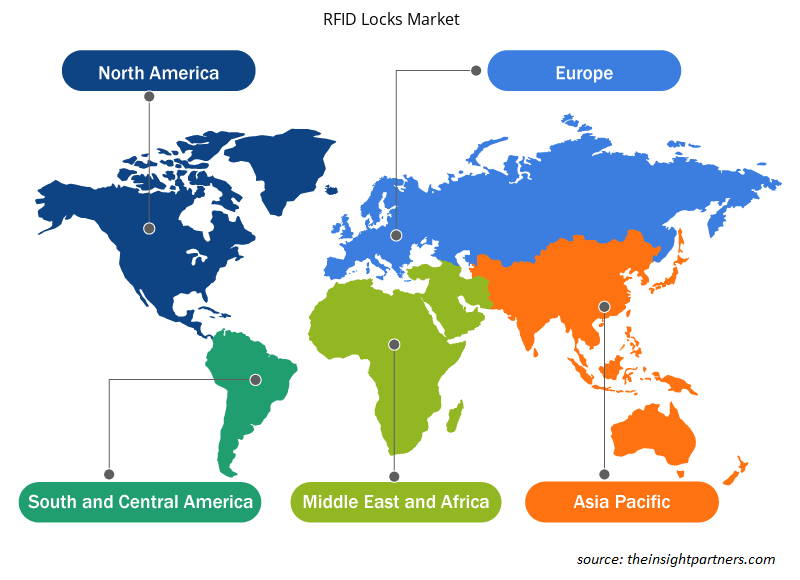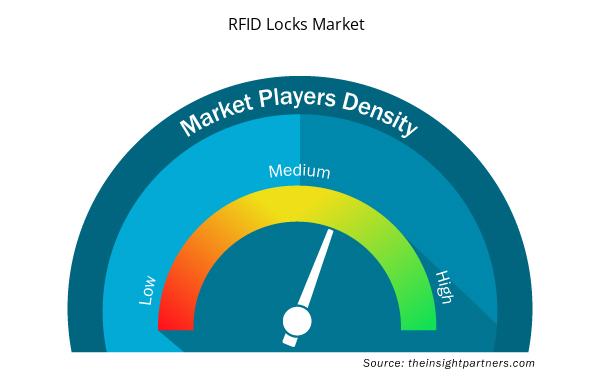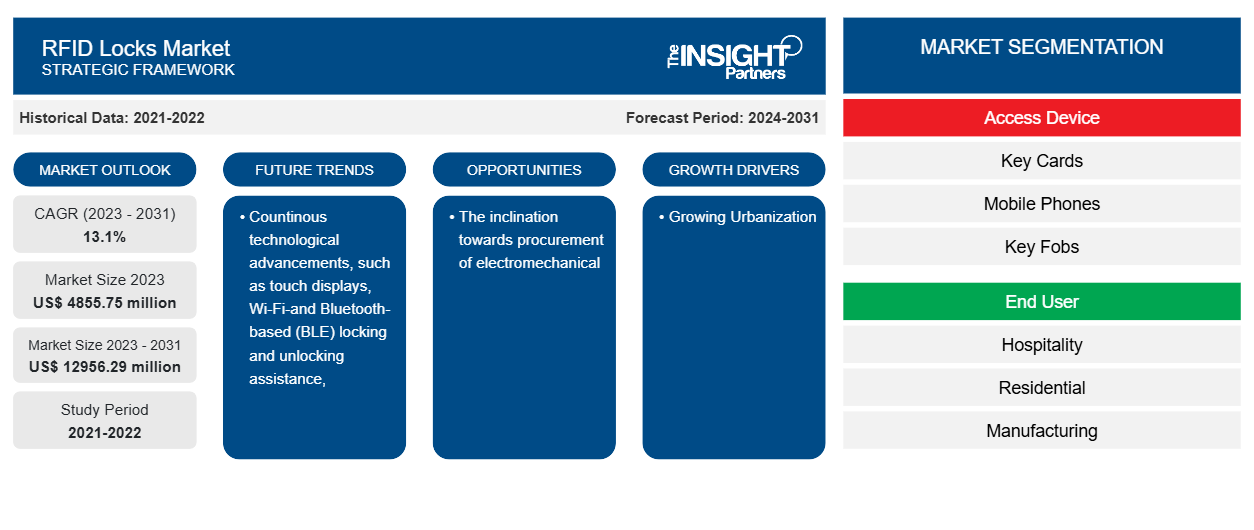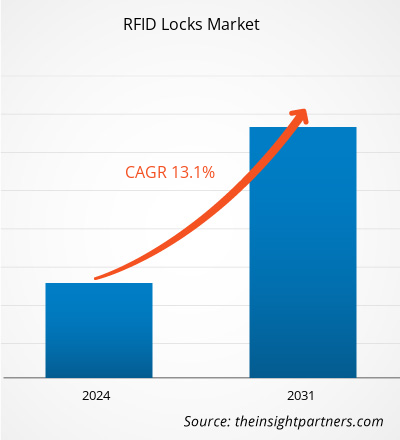RFIDロック市場規模は、2023年の48億5,575万米ドルから2031年には1億2,956万9,000万米ドルに達すると予測されています。市場は2023年から2031年にかけて13.1%のCAGRを記録すると予想されています。タッチディスプレイ、Wi-FiおよびBluetoothベース(BLE)のロック、ロック解除支援などの継続的な技術進歩は、市場動向を洞察するための重要なシステムであり続けると思われます。
RFIDロック市場分析
さまざまな要因、特に世界的にホテルや観光産業が拡大していることが、ホテルを含む新しい商業施設の建設を促進しています。REID ロックの拡大は、より多くの客室を備えたホテルを建設する計画と、ホスピタリティ産業を支援するための政府資金の増加によって直接促進され、市場の拡大を促しています。改善されたアクセス ソリューションの需要を促進する主な要因の 1 つは、都市化です。都市化により人口 100 万人以上の大都市や都市が増えた結果、ますます複雑で高度なインフラストラクチャ ソリューションの必要性が高まっています。この要因も市場の拡大に大きく貢献しています。
RFIDの概要
無線周波数カードを鍵として使用する電子ロックは、RFID ロックまたは ID カード ロックと呼ばれます。従来の接触型カードでは、ロックを開くためにリーダーと物理的に接触する必要がありましたが、RFID テクノロジを使用すると、RFID カードは非接触でそれを行うことができます。RFID テクノロジは、認識システムの一部として、電磁波を使用して信号を伝達します。さらに、その伝統的な概念と高コストのため、RFID ロック システムは、家庭用の機械式ロックの代替として使用されることはありません。さらに、RFID ドア ロックのリアルタイム パフォーマンスは、成功することも失敗することもあります。
要件に合わせてレポートをカスタマイズする
このレポートの一部、国レベルの分析、Excelデータパックなど、あらゆるレポートを無料でカスタマイズできます。また、スタートアップや大学向けのお得なオファーや割引もご利用いただけます。
- このレポートの主要な市場動向を入手してください。この無料サンプルには、市場動向から見積もりや予測に至るまでのデータ分析が含まれます。
RFIDの推進要因と機会
都市化の進展
世界的な人口増加と農村から都市への移住の増加は、都市化の上昇傾向を促進しています。発展途上国では、先進国よりも都市人口の増加率が緩やかです。人々は新しい仕事、家、小売スペースを求めて動き回っているため、望ましくない訪問者を締め出すために建物にアクセス制御とセキュリティ システムが必要です。ますます多くの住宅、オフィス、ホテル、倉庫、その他の場所でスマート ロック システムを使用しています。さらに、キーを持ち歩いたりパスワードを覚えたりする必要がなくなったため、タッチパッド デジタル ロック、指紋ロック、REID カード、その他のスマート ロックの開発により、消費者はさらに便利になりました。住宅部門と商業部門では、アクセス セキュリティ ソリューションの増加が明らかに見られます。
従来のロックシステムよりも電気機械製品の調達への傾向
従来のロックシステムよりも電気機械製品が好まれる傾向が急激に高まっており、この傾向は今後も続くと予想されており、スマートロックシステムのユーザーにはさまざまな成長オプションが提供されます。 REIDロック市場が提供する特徴には、人間工学に基づいたデザイン、適切なデザイン、ADA準拠、ユニバーサル、柔軟性などがあり、ビジネス、特にホテルでの人気が高まっています。 多くの住宅、アパート、学校、小規模な商業ビル、その他の同様の場所では、依然として従来の鍵とドアノブのロックを使用して外部ドアと内部ドアがロックされています。 都市化の進行とセキュリティの需要の高まりにより、スマートロックソリューションは企業オーナーや住宅所有者の間で人気が高まっています。 その結果、電子ロックをよりインテリジェントにするために、ロックメーカーはスマートテクノロジーを統合しています。 したがって、従来のロックシステムよりも電気機械製品の調達への傾向は、予測期間中にRFIDプレーヤーに新しい機会をもたらすと予想されます。
RFIDレポートセグメンテーション分析
RFID 分析の導出に貢献した主要なセグメントは、アプリケーションとエンド ユーザーです。
エンドユーザーに基づいて、RFID は、ホスピタリティ、住宅、製造、小売、自動車、航空宇宙および防衛、政府および公共事業、その他に分類されます。
地域別RFIDシェア分析
RFIDレポートの地理的範囲は、主に北米、アジア太平洋、ヨーロッパ、中東およびアフリカ、南米/中南米の5つの地域に分かれています。RFIDやNFC対応のドアロックなどの高度なセキュリティ技術は、特にホームセキュリティアプリケーションでAPAC地域でよく知られるようになっています。さらに、大手企業は中国や日本などの発展途上国に投資しており、効果的なアクセス制御を可能にする手頃な価格のソリューションの必要性が高まっています。予測期間を通じて、この投資と高度なセキュリティソリューションの使用拡大の結果として、APAC地域の市場は拡大すると予想されます。
RFIDレポートの範囲
RFID のニュースと最近の開発
RFID は、主要な企業出版物、協会データ、データベースなど、一次および二次調査後の定性的および定量的データを収集することによって評価されます。以下は、音声および言語障害の市場における開発と戦略のリストです。
- 2022 年 8 月、Kalahari Resorts & Conventions は、Assa Abloy Global Solutions の RFID ドアロック技術と Visionline アクセス制御管理システムを導入しました。RFID リストバンドまたはキーカードがあれば、ゲストは自分の部屋にアクセスしたり、他のリゾートにアクセスしたり、個人のクレジットカードや現金を持ち歩かなくても商品を購入したりできます。
(出典:カラハリリゾート&コンベンション、プレスリリース)
- 2021 年 9 月、Honeywell は非公開企業の Performix Inc. を買収しました。この買収は、コンプライアンスの迅速化、信頼性の向上、生産量の増加を目指すライフ サイエンス業界の顧客向けに、世界をリードする統合ソフトウェア プラットフォームを構築するという Honeywell の戦略に基づいています。
(出典:ハネウェル、プレスリリース)
RFIDロック市場の地域別分析
予測期間を通じて RFID ロック市場に影響を与える地域的な傾向と要因は、Insight Partners のアナリストによって徹底的に説明されています。このセクションでは、北米、ヨーロッパ、アジア太平洋、中東およびアフリカ、南米および中米にわたる RFID ロック市場のセグメントと地理についても説明します。

- RFIDロック市場の地域別データを入手
RFIDロック市場レポートの範囲
| レポート属性 | 詳細 |
|---|---|
| 2023年の市場規模 | 48億5,575万米ドル |
| 2031年までの市場規模 | 1億295629万米ドル |
| 世界のCAGR(2023年~2031年) | 13.1% |
| 履歴データ | 2021-2022 |
| 予測期間 | 2024-2031 |
| 対象セグメント | アクセスデバイス別
|
| 対象地域と国 | 北米
|
| 市場リーダーと主要企業プロフィール |
|
RFID が市場のプレーヤーの密度を固定: ビジネス ダイナミクスへの影響を理解する
RFID ロック市場は、消費者の嗜好の変化、技術の進歩、製品の利点に対する認識の高まりなどの要因により、エンドユーザーの需要が高まり、急速に成長しています。需要が高まるにつれて、企業は提供を拡大し、消費者のニーズを満たすために革新し、新たなトレンドを活用し、市場の成長をさらに促進しています。
市場プレーヤー密度とは、特定の市場または業界内で活動している企業または会社の分布を指します。これは、特定の市場スペースに、その市場規模または総市場価値に対してどれだけの競合相手 (市場プレーヤー) が存在するかを示します。
RFIDロック市場で事業を展開している主要企業は次のとおりです。
- アッサ・アブロイAB
- バイフー株式会社
- デジロック(セキュリティピープル株式会社)
- ドルマカバグループ
- ユーロロック SA NV (ロウ・アンド・フレッチャー・グループ)
- ゴドレジ・アンド・ボイス製造会社
免責事項:上記の企業は、特定の順序でランク付けされていません。

- RFIDロック市場のトップキープレーヤーの概要を入手
RFIDロック市場レポートの対象範囲と成果物
「RFIDロック市場規模と予測(2021〜2031年)」レポートでは、以下の分野をカバーする市場の詳細な分析を提供しています。
- 対象範囲に含まれるすべての主要市場セグメントの世界、地域、国レベルでの市場規模と予測
- 市場の動向(推進要因、制約、主要な機会など)
- 今後の主な動向
- 詳細なPEST/ポーターの5つの力とSWOT分析
- 主要な市場動向、主要プレーヤー、規制、最近の市場動向を網羅した世界および地域の市場分析
- 市場集中、ヒートマップ分析、主要プレーヤー、最近の動向を網羅した業界の状況と競争分析
- 詳細な企業プロフィール
- 過去2年間の分析、基準年、CAGRによる予測(7年間)
- PEST分析とSWOT分析
- 市場規模価値/数量 - 世界、地域、国
- 業界と競争環境
- Excel データセット


- Emergency Department Information System (EDIS) Market
- Energy Recovery Ventilator Market
- Asset Integrity Management Market
- UV Curing System Market
- Hydrocephalus Shunts Market
- Microplate Reader Market
- Compounding Pharmacies Market
- Organoids Market
- Identity Verification Market
- Arterial Blood Gas Kits Market

Report Coverage
Revenue forecast, Company Analysis, Industry landscape, Growth factors, and Trends

Segment Covered
This text is related
to segments covered.

Regional Scope
North America, Europe, Asia Pacific, Middle East & Africa, South & Central America

Country Scope
This text is related
to country scope.
よくある質問
The key players holding majority shares in the global RFID locks market are Assa Abloy AB, Bai Fu Co. Ltd, Digilock (Security People Inc.), Dormakaba Group, and Euro-locks SA NV (Lowe and Fletcher Group).
The global RFID locks market is expected to reach US$ 12956.29 million by 2031.
The global RFID locks market was estimated to be US$ 4855.75 million in 2023 and is expected to grow at a CAGR of 13.1 % during the forecast period 2023 - 2031.
The increasing demand for real-time data analytics, the Increasing use of big data and analytics and the inclination towards procurement of electromechanical products over traditional locking systems are the major factors that propel the global RFID locks market.
Continuous technological advancements, such as touch displays and Wi-Fi and Bluetooth-based (BLE) locking and unlocking assistance, are anticipated to play a significant role in the global RFID locks market in the coming years.
Trends and growth analysis reports related to Electronics and Semiconductor : READ MORE..
The Insight Partners performs research in 4 major stages: Data Collection & Secondary Research, Primary Research, Data Analysis and Data Triangulation & Final Review.
- Data Collection and Secondary Research:
As a market research and consulting firm operating from a decade, we have published and advised several client across the globe. First step for any study will start with an assessment of currently available data and insights from existing reports. Further, historical and current market information is collected from Investor Presentations, Annual Reports, SEC Filings, etc., and other information related to company’s performance and market positioning are gathered from Paid Databases (Factiva, Hoovers, and Reuters) and various other publications available in public domain.
Several associations trade associates, technical forums, institutes, societies and organization are accessed to gain technical as well as market related insights through their publications such as research papers, blogs and press releases related to the studies are referred to get cues about the market. Further, white papers, journals, magazines, and other news articles published in last 3 years are scrutinized and analyzed to understand the current market trends.
- Primary Research:
The primarily interview analysis comprise of data obtained from industry participants interview and answers to survey questions gathered by in-house primary team.
For primary research, interviews are conducted with industry experts/CEOs/Marketing Managers/VPs/Subject Matter Experts from both demand and supply side to get a 360-degree view of the market. The primary team conducts several interviews based on the complexity of the markets to understand the various market trends and dynamics which makes research more credible and precise.
A typical research interview fulfils the following functions:
- Provides first-hand information on the market size, market trends, growth trends, competitive landscape, and outlook
- Validates and strengthens in-house secondary research findings
- Develops the analysis team’s expertise and market understanding
Primary research involves email interactions and telephone interviews for each market, category, segment, and sub-segment across geographies. The participants who typically take part in such a process include, but are not limited to:
- Industry participants: VPs, business development managers, market intelligence managers and national sales managers
- Outside experts: Valuation experts, research analysts and key opinion leaders specializing in the electronics and semiconductor industry.
Below is the breakup of our primary respondents by company, designation, and region:

Once we receive the confirmation from primary research sources or primary respondents, we finalize the base year market estimation and forecast the data as per the macroeconomic and microeconomic factors assessed during data collection.
- Data Analysis:
Once data is validated through both secondary as well as primary respondents, we finalize the market estimations by hypothesis formulation and factor analysis at regional and country level.
- Macro-Economic Factor Analysis:
We analyse macroeconomic indicators such the gross domestic product (GDP), increase in the demand for goods and services across industries, technological advancement, regional economic growth, governmental policies, the influence of COVID-19, PEST analysis, and other aspects. This analysis aids in setting benchmarks for various nations/regions and approximating market splits. Additionally, the general trend of the aforementioned components aid in determining the market's development possibilities.
- Country Level Data:
Various factors that are especially aligned to the country are taken into account to determine the market size for a certain area and country, including the presence of vendors, such as headquarters and offices, the country's GDP, demand patterns, and industry growth. To comprehend the market dynamics for the nation, a number of growth variables, inhibitors, application areas, and current market trends are researched. The aforementioned elements aid in determining the country's overall market's growth potential.
- Company Profile:
The “Table of Contents” is formulated by listing and analyzing more than 25 - 30 companies operating in the market ecosystem across geographies. However, we profile only 10 companies as a standard practice in our syndicate reports. These 10 companies comprise leading, emerging, and regional players. Nonetheless, our analysis is not restricted to the 10 listed companies, we also analyze other companies present in the market to develop a holistic view and understand the prevailing trends. The “Company Profiles” section in the report covers key facts, business description, products & services, financial information, SWOT analysis, and key developments. The financial information presented is extracted from the annual reports and official documents of the publicly listed companies. Upon collecting the information for the sections of respective companies, we verify them via various primary sources and then compile the data in respective company profiles. The company level information helps us in deriving the base number as well as in forecasting the market size.
- Developing Base Number:
Aggregation of sales statistics (2020-2022) and macro-economic factor, and other secondary and primary research insights are utilized to arrive at base number and related market shares for 2022. The data gaps are identified in this step and relevant market data is analyzed, collected from paid primary interviews or databases. On finalizing the base year market size, forecasts are developed on the basis of macro-economic, industry and market growth factors and company level analysis.
- Data Triangulation and Final Review:
The market findings and base year market size calculations are validated from supply as well as demand side. Demand side validations are based on macro-economic factor analysis and benchmarks for respective regions and countries. In case of supply side validations, revenues of major companies are estimated (in case not available) based on industry benchmark, approximate number of employees, product portfolio, and primary interviews revenues are gathered. Further revenue from target product/service segment is assessed to avoid overshooting of market statistics. In case of heavy deviations between supply and demand side values, all thes steps are repeated to achieve synchronization.
We follow an iterative model, wherein we share our research findings with Subject Matter Experts (SME’s) and Key Opinion Leaders (KOLs) until consensus view of the market is not formulated – this model negates any drastic deviation in the opinions of experts. Only validated and universally acceptable research findings are quoted in our reports.
We have important check points that we use to validate our research findings – which we call – data triangulation, where we validate the information, we generate from secondary sources with primary interviews and then we re-validate with our internal data bases and Subject matter experts. This comprehensive model enables us to deliver high quality, reliable data in shortest possible time.


 このレポートの無料サンプルを入手する
このレポートの無料サンプルを入手する